If you want to identify some of the birds of the Everglades in Florida, I’ve included my pictures to help you identify the ones you see. Be sure to check out my Everglades Itinerary to help you planning your visit!
*Last updated February 1, 2025

Birds of the Everglades
Table of Contents
-
- Anhinga
- Great Egret
- Great Blue Heron
- Little Blue Heron
- Tricolored Heron
- Black-crowned Night Heron
- Yellow-crowned Night Heron
- Wood Stork
- White Ibis
- Double-crested Cormorant
- Brown Pelican
- American White Pelican
- Roseate Spoonbill
- Purple Gallinule
- Osprey
- Red-shouldered Hawk
- Fish Crow
- Royal Tern
- Black Skimmer
- Laughing Gull
- Willet
- Red-bellied Woodpecker
- Bald Eagle
- Turkey Vulture
- Green Heron
- Snail Kite
Anhinga
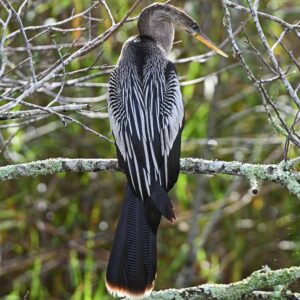
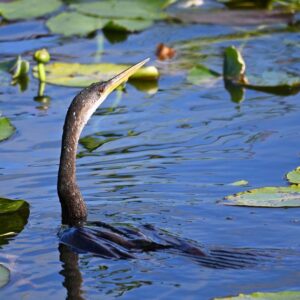
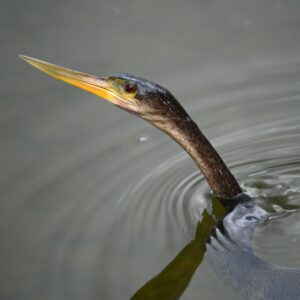
Anhinga was my favorite bird from the Everglades. It was fun to watch them swim and hunt for fish. Also, they have the nickname of the “snake bird” due to their long, snake-like necks that protrude as they swim through the water. Additionally, you can commonly see them sunning themselves with wings spread out, as seen in the first picture at the top of this page. Also, they live year-round in the Everglades.
Location: You can see them throughout the Everglades, especially around water. We saw them at the Anhinga Trail (by the Royal Palm Visitor Center). Additionally, we saw them swimming by the turnoff from the main road to the Royal Palm Visitor Center. There is standing water on both sides of the main road, and it was a great place to see anhinga, other birds, fish and alligators.
Great Egret

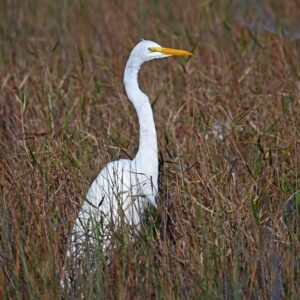
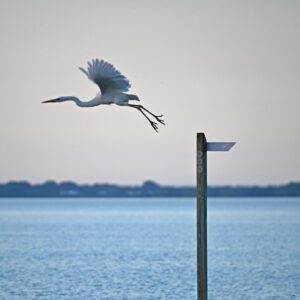
The Great Egret is what many people picture when thinking of the wading Everglades birds. The large, white bird is a majestic site to see with it graceful long neck, wading in the wetlands. It is second in size only behind the Great Blue Heron. Additionally, they live year-round in the Everglades.
Location: You will find the Great Egrets throughout the Everglades as you drive along the main road. We saw them hunting prey in the wetlands and marsh, as well as the Florida Bay boat tour from Flamingo Adventures.
Great Blue Heron
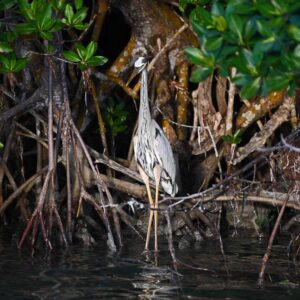
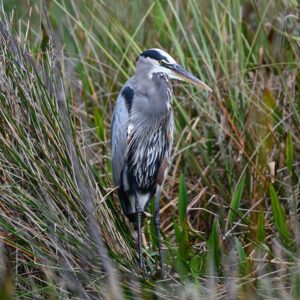
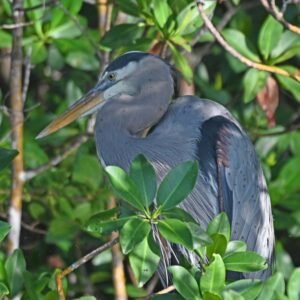
The Great Blue Heron is the largest bird in the Everglades. Also, it is amazing to see them out hunting in the mangroves or in the marsh. However, in the mangroves, you can see the camouflage of their long legs around the mangrove roots. Also, they live year-round in the Everglades.
Location: We saw them both in watery marshes (around Anhinga Trail) as well as on the Florida Bay boat tour.
Little Blue Heron
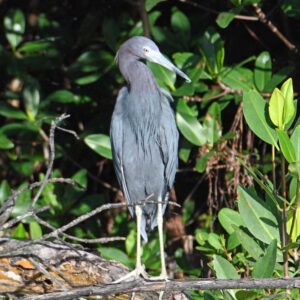
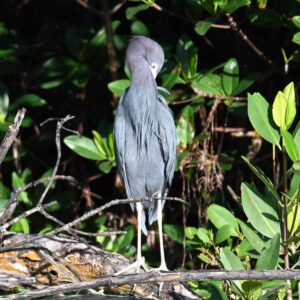
The Little Blue Heron is smaller than its cousin the Great Blue Heron. However, it is still a large bird. Additionally, their colors are more monochromatic, dark bluish-gray tint. Also, they live year-round in the Everglades.
Location: We saw the Little Blue Heron in the mangroves on the Florida Bay boat tour.
Tricolored Heron
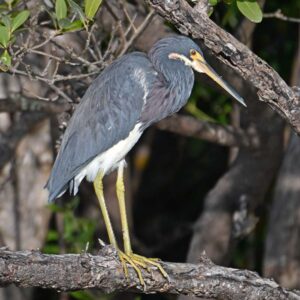
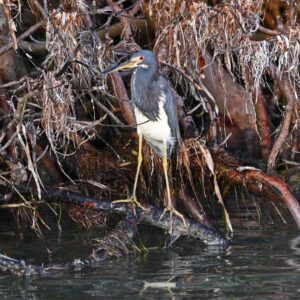

The Tricolored Heron is similar outer plumage of the Little Blue Heron, but with white around the neck and belly. Additionally, they also have bright, red eyes that are common with other night herons. Also, they live year-round in the Everglades.
Location: We spotted Tricolored Herons both in the watery marshes and in the mangroves on the Florida Bay boat tour.
Black-Crowned Night Heron
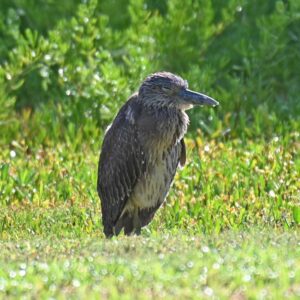
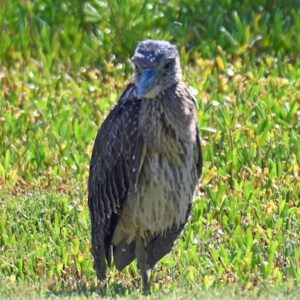
The Black Crowned Night Heron above is a juvenile. However, adult Black Crowned Night Herons are white bellied with dark wings and red eyes. Additionally, they live year-round in the Everglades.
Location: We spotted this Black Crowned Night Heron on the grass outside of the Guy Bradley Visitor Center.
Yellow-Crowned Night Heron
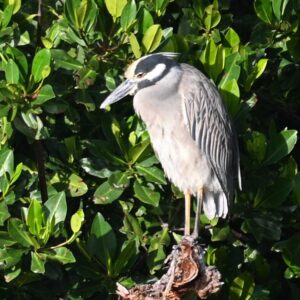
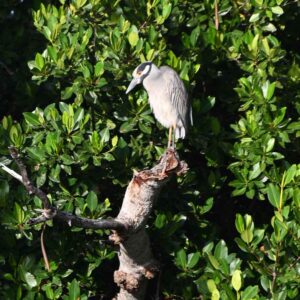
The Yellow Crowned Night Heron is smaller than the other herons. Additionally, it is recognizable by its black and white head with light-yellow head feathers. Also, they live year-round in the Everglades.
Location: We saw the Yellow Crowned Night Heron among the mangroves on our Florida Bay boat tour.
Wood Stork
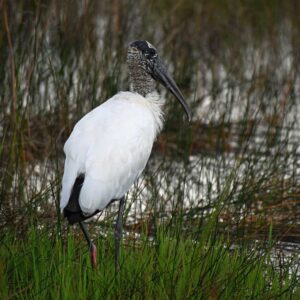
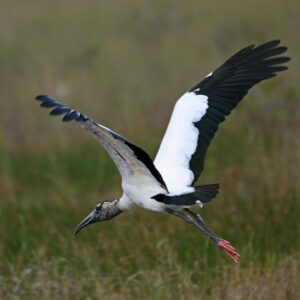
The Wood Stork was “endangered” up until recently. However, they were downgraded to “threatened” in 2014. Fortunately, we were able to see a few of them in the wetland marsh areas of the Everglades. Additionally, they live year-round in the Everglades.
Location: We saw a Wood Stork on the main road at the turnoff to the Anhinga Trail (Royal Palm Visitor Center). There is a small pond that passes under the road and was a wonderful place to spot various birds, fish and alligators.
White Ibis
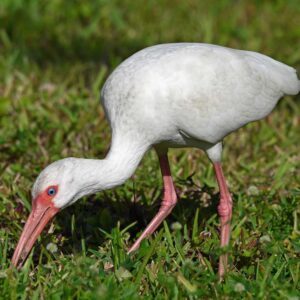
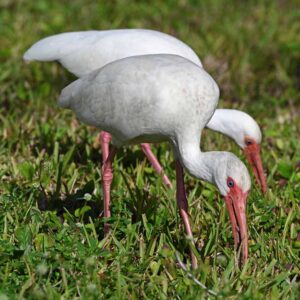
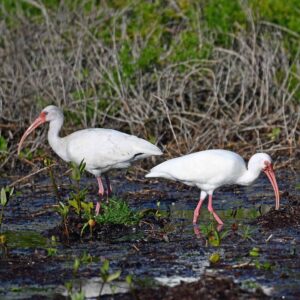
The White Ibis is a commonly seen bird throughout the Everglades. Additionally, they are seen pecking in the grass and mud searching for worms, insects and small crustaceans. Also, they live year-round in the Everglades.
Location: We saw them frequently in the Everglades, especially on the Guy Bradley Trail and Anhinga Trail.
Double-Crested Cormorant

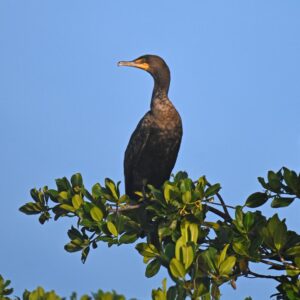
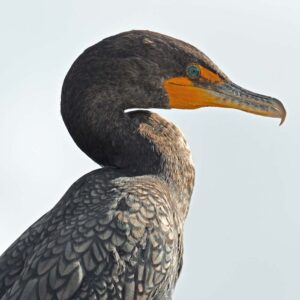
The Double-crested Cormorant is a larger bird that has a darker plumage, orange coloring around the head and beautiful emerald-green eyes. Additionally, they live year-round in the Everglades.
Location: We saw Double-crested Cormorants throughout the park and on the Florida Bay boat tour.
Brown Pelican
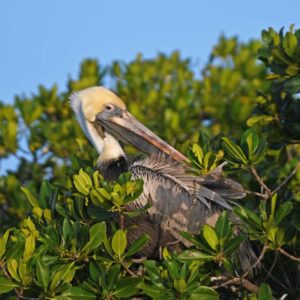
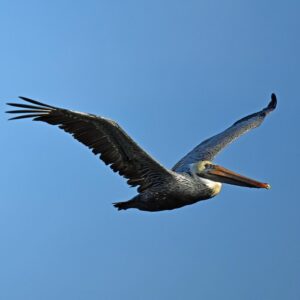
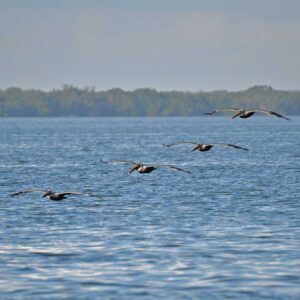
The Brown Pelican is more common than the White Pelican and is non-migratory, so they live year-round in the Everglades.
Location: We saw Brown Pelicans both from the Florida Bay shoreline and on the Florida Bay boat tour.
American White Pelican
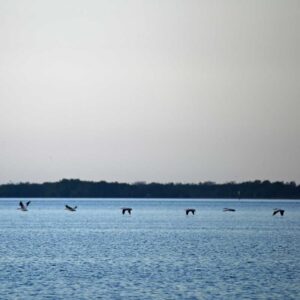
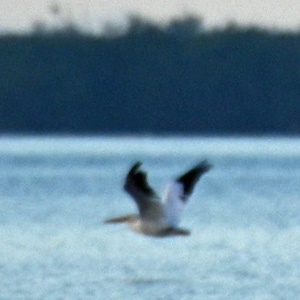
There are two species of pelicans in Florida, and both can be found in the Everglades. The White Pelican is overall whiter in color. Additionally, breeding adults have black tipped wings. It is zoomed in and a bit grainy, but you can see the black tips in the second photo. However, it is a migratory bird, so it only spends winters in the Everglades and migrates northwest to breed in the summers.
Location: We saw White Pelicans both from the Florida Bay shoreline and on the Florida Bay boat tour.
Roseate Spoonbill
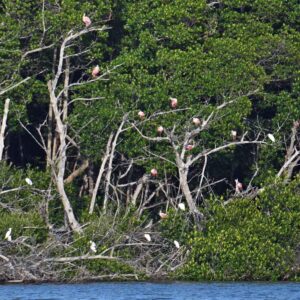
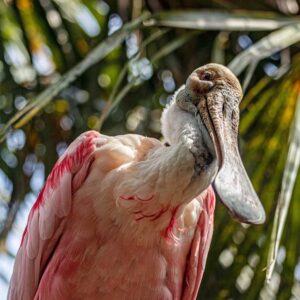
Close-up image courtesy of Pexels, photographed by Amanda Moore
The Roseate Spoonbill is easily identifiable by its pinkish-red feathers and spoon-shaped bill. Also, they live year-round in the Everglades.
Location: We spotted a large flock of Roseate Spoonbills on the Florida Bay boat tour. However, the boat could not get closer due to shallow waters, so I only got pictures from further away.
Purple Gallinule
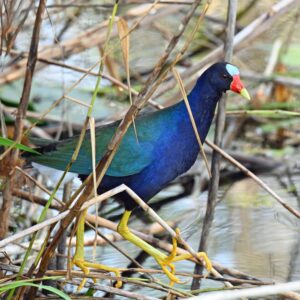
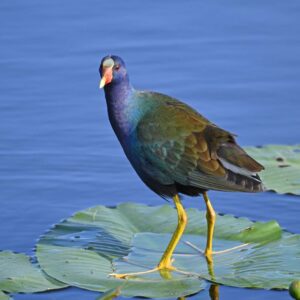
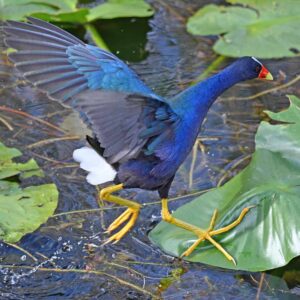
The Purple Gallinule is one of the more colorful birds. They have a radiant blue/green plumage, turquoise and red head, with a yellow beak. Additionally, they are fun to watch hop among lily pads looking for food. Also, they live year-round in the Everglades.
Location: We spotted them in wetlands, especially around the Anhinga Trail.
Osprey

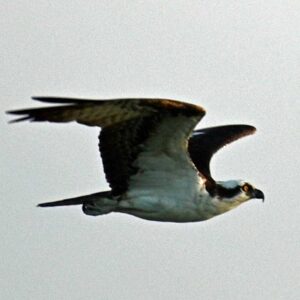
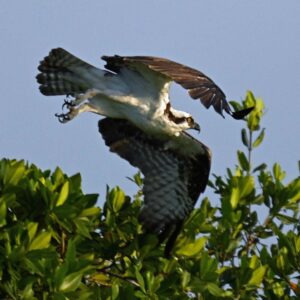
The Osprey is a bird of prey commonly found fishing along the shore. Also, they have a white body and brown wings. Additionally, they live year-round in the Everglades.
Location: They are found along the shoreline, and we saw a few different ospreys on the Florida Bay boat tour.
Red-Shouldered Hawk
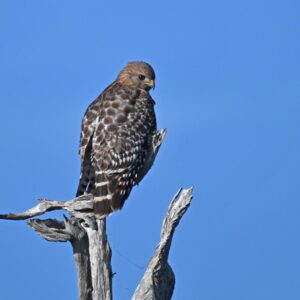
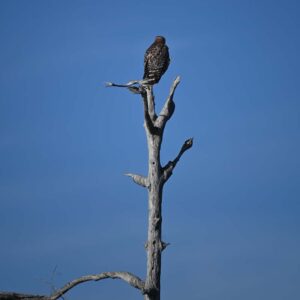
The Red-shouldered hawk is another bird of prey found in wetland marshes. Also, you can identify them with their mottled brown and white plumage. Additionally, they live year-round in the Everglades.
Location: We spotted the Red-shouldered Hawk on the Mahogany Hammock Trail.
Fish Crow
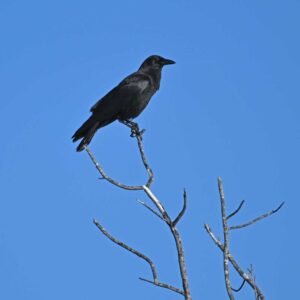
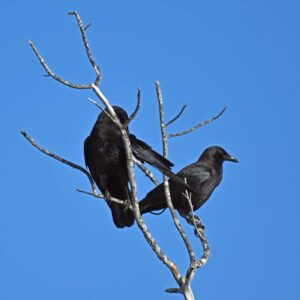
The Fish Crow looks remarkably similar to the more common American Crow. However, they are a distinct species and are found along wetlands. Also, they live year-round in the Everglades.
Location: We spotted the Fish Crow throughout the Everglades, especially near the Mahogany Hammock Trail.
Royal Tern
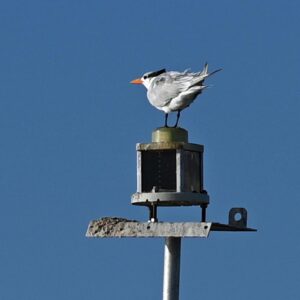
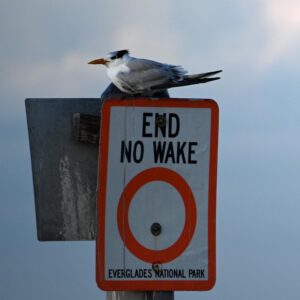
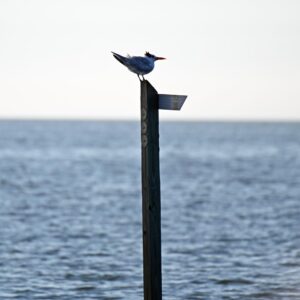
The Royal Tern is a small sea bird found along the gulf coastline. Additionally, they have white and grey plumage with a black crown. The non-breeding tern will have a thinner black line, where a breeding adult will have a fully black head above the eyes. Also, they live year-round in the Everglades.
Location: We saw Royal Terns along the shoreline and on the Florida Bay Boat Tour.
Black Skimmer
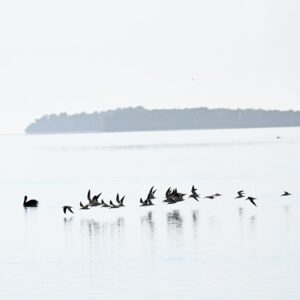
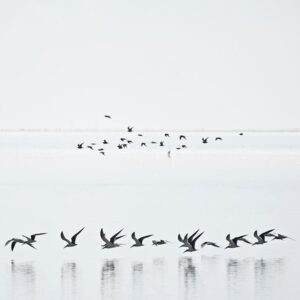
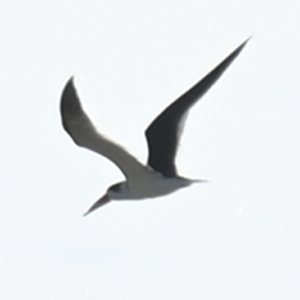
I had some trouble identifying this bird. First, it was morning and I overexposed the pictures trying to get a better exposure on the bird itself. Second, this bird doesn’t seem to show up on a lot of Everglades bird lists. However, they do show up as being found in Florida Bay and they are identified by the black backs, white belly and long beak. Additionally, they fly in flocks and soar close to the water to catch fish.
Location: We saw the Black Skimmers along the shoreline in Flamingo on the Guy Bradley Trail near Flamingo Campground.
Laughing Gull
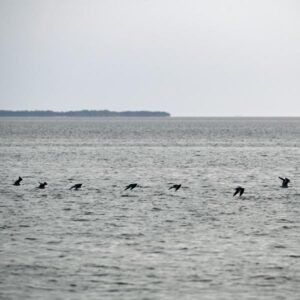
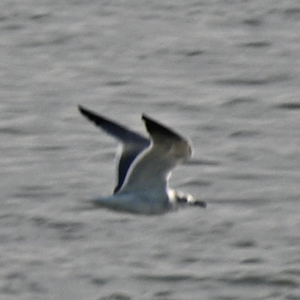
The laughing gull was in a flock around bay as well. They were smaller than the black skimmer. Additionally they a shorter, black beak and black head marking, which is typical for a non-breeding adult.
Location: We saw the Laughing Gulls during the Florida Bay boat tour.
Willet

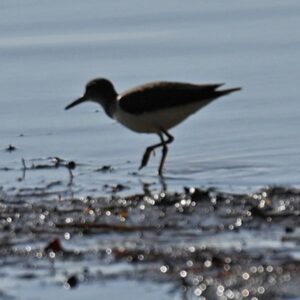
The Willet is a sea bird found along the gulf coastline. It is a migratory bird, so they are only found in the Everglades during the winter and then head north to breed in the summer.
Location: We saw Willets along the shore on the Guy Bradley Trail.
Red-Bellied Woodpecker
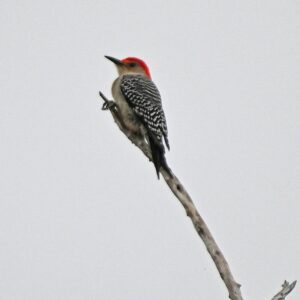
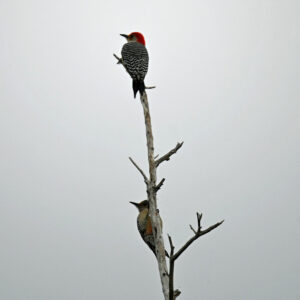
The Red-bellied woodpecker can be found throughout the eastern, southern, and mid-western United States. Also, in the second picture, you can see the difference between the colorful adult woodpecker on the top and the browner, juvenile woodpecker below. Additionally, they live year-round in the Everglades.
Location: We spotted the Red Bellied Woodpecker off the main road to Flamingo.
Bald Eagle
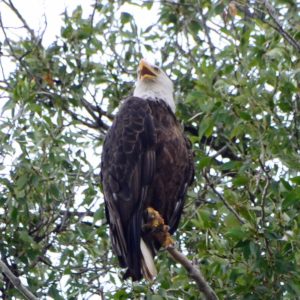

The Bald Eagle is really the example of what the clean water program has accomplished in the United States. In the 1950s, Bald Eagle populations had disappeared from the majority of our country except for Florida and Alaska. Today, they are located throughout much of the country. The Bald Eagle lives year-round in the Everglades.
Location: We spotted a bald eagle on the Florida Bay boat tour, but unfortunately I didn’t get a picture. The above bald eagle pictures are from a trip to Grand Teton and a bird sanctuary in Ohio.
Turkey Vulture
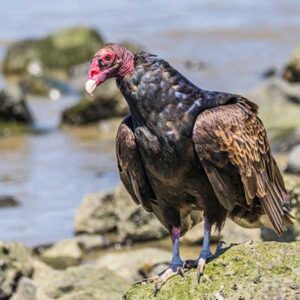
Image courtesy of Pexels, photographed by Robert So
We saw Turkey Vultures on our first night in the Flamingo Campground. However, I didn’t get a picture as I was busy setting up our camper. Unfortunately, we never saw them again on our visit. Additionally, they live year-round in the Everglades.
Location: Flamingo Campground
Green Heron
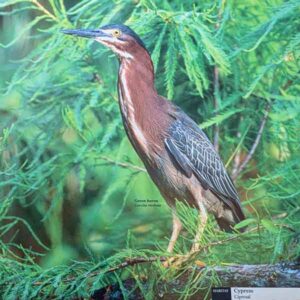
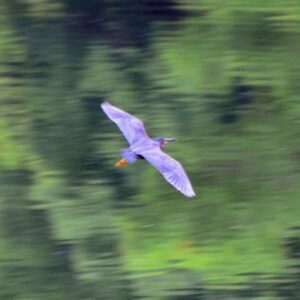
We didn’t see a Green Heron in the Everglades, but I have a picture of one from a sign so they must be around the area. We saw the sign while around a Cyprus forest board walk trail, which was about half way down the main road from Homestead to Flamingo. The second picture is a green heron that I photographed in Bernheim Forest near Louisville, Kentucky.
Location: Cyprus Forest
Snail Kite
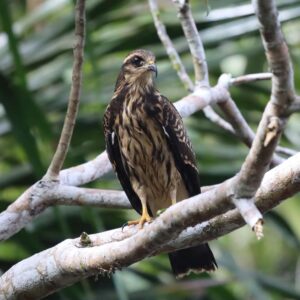
Image courtesy of Pexels, photographed by Paul Hoekman
The Snail Kite is one of the rarer birds in the Everglades, so unfortunately we never saw one. In fact, Florida is the only state in the US that is home to Snail Kites. Snail Kites numbers in Florida dipped below one thousand in the mid-2000s. Today, they are listed as Federally Endangered. However, they are found in larger numbers in South America. Additionally, they live year-round in the Everglades.
